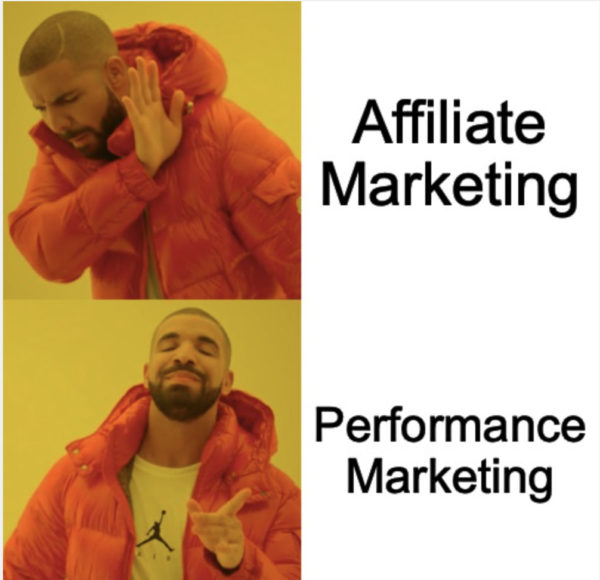Performance marketing is one of the hottest trends in the digital marketing world. Featuring many advantages over traditional advertising methods, it’s no wonder massive companies like Apple and other Fortune 500 companies are flocking towards it.
According to a 2017 study by MediaKix, 80% of brands and 84% of publishers currently leverage performance and affiliate marketing.
The true number of brands using performance marketing today is much higher than that.
In this article, we’ll jump into what performance marketing is, why it’s beneficial, and other common questions surrounding the term.
If you’d like to track all of your performance and affiliate marketing efforts in one place, sign up for Afflytics and get two weeks of reporting on us.
Table of Contents
What is Performance Marketing?
Performance marketing is a method of advertising in which merchants, also known as advertisers or retailers, connect with affiliates and publishers in order to drive traffic to offers.
By setting clear defined key performance indicators (KPIs), such as clicks, leads, sales, and more, merchants are able to set performance based CPAs on a specific action that guarantee an ROI for both sides.
Why use Performance Marketing?
Performance marketing is one of the most attractive methods to advertisers as it’s directly measurable, in real time. Advertisers don’t have to worry about seeing an ROI from ad spend.
Traditional native advertising like CPM display advertising and banner ads don’t guarantee sales, just impressions and brand awareness.
By setting up performance marketing agreements with publishers (marketing companies) with a desired target audience, both sides are able to profit.
Overall, it’s a low risk, cost effective, return on investment focused marketing channel.
Performance Marketing vs Affiliate Marketing
There aren’t too many differences between performance marketing and affiliate marketing. In fact, all performance marketing is affiliate marketing.
Just not all affiliate marketing would be considered performance marketing.
Make sense?
The main distinction is that affiliate marketing falls under the umbrella term of performance marketing, along with influencer marketing, search engine marketing, and more.
Due to some of the widespread marketing done in the affiliate marketing world, the term “affiliate marketing” has received a bit of a bad image as a pyramid scheme, easy way to make money online, or the laptop on a beach digital nomad business.
Anyone that actually does affiliate marketing knows all the above labels are incorrect. Regardless, the name performance marketing has given the concept more life under a more “professional” term.
The Performance Marketing Equation
Let’s cover all the key players inside the performance marketing equation.
All of these components are what allow the performance marketing ecommerce ecosystem to thrive, and what contributed to over $12 billion in performance marketing spending in 2020.
The Advertiser
The advertiser, also known as the merchant, are the ones responsible for setting up the performance marketing program, and the measurable actions they want to payout for.
The Affiliate Network
Affiliate networks are responsible for hosting the advertisers performance marketing program, along with key technical features like tracking, attribution, and payouts to publishers.
Examples of affiliate networks that host performance marketing programs would be networks like Impact, Awin, Clickbank, and more.
The Publisher
The publisher, or the affiliate, is responsible for the actual marketing. This type of marketing can take many forms, via display advertising, SEO (Search Engine Optimization), CPC (Cost Per Click), social media, and more.
By collecting an audience for the merchant, publishers are able to get eyes on offers from a different marketing angle. This can be extremely powerful when the publisher is extremely trusted by their audience.
Affiliate Managers
Affiliate managers have a key role as well, and manage the relationship between the publisher and the advertiser. Some advertisers have affiliate managers of their own, while others rely on the affiliate network or a marketing agency’s affiliate managers.
The success of a performance marketing program can entirely depend on how passionate, dedicated, and punctual an affiliate manager is to a given campaign.
Some of the tasks affiliate managers might do are optimizing landing pages of publishers, improving link placement, commission negotiation, and more. Affiliate managers will have done tons of A/B testing, learning how to squeeze the most value out of the relationship.
Consumer
The consumer is the one that drives the entire process. Without their funds none of the rest of these players have roles. Consumers buy the products or services of a merchant hosted on affiliate networks. The affiliate network or program then pays the publisher or affiliate.
Performance Marketing Payment Models
There’s various metrics advertisers can set for their publishers to hit in order to payout.
Pay Per Sale (PPS)
Pay Per Sale is the most common way for advertisers to credit publishers, as it’s pretty high on the value chain. Assuming an advertisers customer value is higher than the payout to a publisher, there is no way advertisers won’t see a return on their ad spend.
Pay Per Lead (PPL)
Pay per lead is the next common method of paying publishers and involves crediting them any time they successfully drive a lead the advertisers way. By identifying a cost-per-lead (CPL) that’s profitable for the merchant, a performance marketing campaign can be set up using any amount up to that as the payout.
The definition of a lead will depend on the terms inside the advertisers performance marketing program terms.
A lead can be anything from:
- Account sign up
- Form completion
- Submitted email address
- Mobile app download
This is slightly lower on the value chain, and is likely why it’s less common than a PPS model. Leads can, but do not automatically guarantee a return on investment and are subject to fraud.
MorningBrew, the finance newsletter, is famous for growing their list to over 1.5 million users through a powerful pay per lead performance marketing system.
Pay Per Click (PPC)
Lowest on the value chain, would be Pay per click. Advertisers set the price they are willing to pay affiliates for clicks, and via tracking (typically by affiliate networks) publishers earn income.
Similarly to PPL, PPC isn’t super common, because the main draw to performance marketing is the guarantee of ROI, and when clicks are the metric used, it would not necessarily guarantee ROI.
What’s an Example of Performance Marketing?
So let’s use Apple’s performance marketing program as an example.
Apple, who would be the advertiser in this example, has dozens of awesome products to sell from the iPhone 12 to Macbook Pros. Due to complex equations tested on a massive sample size, Apple knows their cost per acquisition, and what price they can sell these products at and make a profit.
Because of this, they decided to set up a performance marketing program using Impact, who would be the affiliate network in this example.
Impact handles lots of aspects of performance marketing for Apple like partner applications, click and sales tracking, cookies, payouts and much much more.
Apple will generate an affiliate agreement hosted on Impact, outlining the terms of their program, like rules affiliate marketers must follow, the commission and payout structure, and more.
Publishers and affiliate marketers can then apply to Apple’s program. In this specific scenario Apple is very picky with who gets accepted, but most other merchants are much more lenient.
By applying to Apples performance marketing program, affiliates are by default accepting their rules.
Inside of Impact, publishers have access to tons of tools and the ability to create tracking links. They can place these on their blogs, email lists, advertisements, social media accounts, you name it.
In the event an affiliate manager is present, it’s their job to coordinate with the publisher and the merchant to get the most out of their cooperation. Let’s say our publisher has a blog post on the best laptops of 2021, and list’s Apples Macbook Pro as #2 on the list. Affiliate managers would be doing Apple a massive favor by coordinating an agreement where the publisher moves apple up to #2.
Where Can I Find Performance Marketing Offers?
Remember how earlier we said 84%+ of brands are using performance marketing? So there’s plenty of performance marketing offers out there for you to promote.
If there are specific companies you want to promote, you can contact them asking if they have any performance or affiliate marketing programs. A simple Google search will usually reveal any programs advertisers have setup.
Advantages of Performance Marketing
A main advantage of performance marketing is the ability to diversify a merchants marketing strategy. It’s not an excuse for brands to forget about certain channels, but a chance for supplemental traffic.
While a brand may be nailing their online presence on search engines, LinkedIn, and Instagram, they may be missing out on other social media platforms.
Rather than attempting to set up entire teams and marketing efforts to dominate all of the algorithms, they can set up a performance marketing campaign so creators on the platforms can do the marketing for them.
Conclusion
Overall, performance marketing is an exciting upcoming online marketing strategy utilized by brands all over the world. By setting up campaigns targeting a desired action, merchants can add tons of supplemental traffic to their brand marketing.
It becomes a win-win situation where both sides are optimizing the KPIs that make them both the most money.
To recap, the main components of the performance marketing equation are the advertisers/merchant, affiliate/publisher, affiliate network, and the affiliate managers. All of these pieces are working together to raise brand awareness and more profit.
What are your thoughts on performance marketing?
Have you setup a program of your own?
Or perhaps you’re an affiliate for one?
Let us know in the comments!



